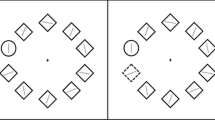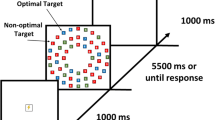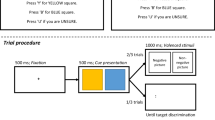Abstract
Anxiety states are associated with increasedattention to threat and a greater likelihood of reachinga pessimistic interpretation of ambiguous events.Existing models of this selective processing possess features that are difficult to reconcile withcurrent experimental findings. In this paper we build onthese earlier ideas to develop a new model,incorporating adaptations that allow it to accountbetter for the accumulating data. Essential featuresare that attributes or meanings of stimuli are processedin parallel and compete for attentional resources. Inputfrom a threat evaluation system (TES) strengthens activation of threat-related attributes, to anextent influenced by anxiety level. Such activation canbe countered, within limits, by voluntary task-relatedeffort, and the balance between these opposing influences determines the extent of anyattentional or interpretative bias seen. Such a model isplausible from an evolutionary perspective and isconsistent with neurological evidence concerning theacquisition and extinction of aversiveconditioning.
Similar content being viewed by others
REFERENCES
Amir, N., McNally, F. J., Riemann, B. C., Burns, J., Loenz, M., & Mullen, J. T. (1996). Suppression of the emotional Stroop effect by increased anxiety in patients with social phobia. Behavior Research and Therapy, 34, 945–948.
Bouton, M. E. (1994). Context, ambiguity, and classical conditioning. Current Directions in Psychological Science, 3, 49–52.
Bradley, B. P., & Mathews, A. (1983). Negative self-schemata in clinical depression. British Journal of Clinical Psychology, 22,173–181.
Broadbent, D. E., & Broadbent, M. (1988). Anxiety and attentional bias: State and trait. Cognition and Emotion, 2, 165–83.
Bryne, A., & Eysenck, M. W. (1995). Trait anxiety, anxious mood, and threat detection. Cognition and Emotion, 9, 549–562.
Cahill, L., Prins, B., Weber, M., & McGaugh, J. L. (1994). b-Adrenergic activation and memory for emotional events. Nature, 371,702–704.
Calvo, M. G., & Castillo, M. D. (1997). Mood congruent bias in interpretation of ambiguity: Strategic processes and temporary activation. Quarterly Journal of Experimental Psychology: Human Experimental Psychology, 50A, 163–182.
Calvo, M. G., Eysenck, M. W., & Estevez, A. (1994). Ego-threat interpretative bias in test anxiety: On-line inferences. Cognition and Emotion, 8,127–146.
Carr, T. H., & Dagenbach, D. (1990). Semantic priming and repetition from masked words: Evidence for a center-surround attentional mechanism in perceptual recognition. Journal of Experimental Psychology: Learning, Memory and Cognition, 16,341–350.
Cohen, J. D., Dunbar, K., & McCleland, J. L. (1990). On the control of automatic processes: A parallel distributed processing account of the Stroop effect. Psychological Review, 99,45–77.
Corr, P. J., Pickering, A. D., & Gray, J. A. (1997). Personality, punishment and procedural learning: A test of J. A. Gray's anxiety theory. Journal of Personality and Social Psychology, 73,337–344.
Derryberry, D., & Reed, M. A. (1994). Temperament and attention: Orienting toward and away from positive and negative signals. Journal of Personality Social Psychology, 66,1128–1139.
Eysenck, M. W., Mogg, K., May, J., Richards, A., & Mathews, A. (1991). Bias in interpretation of ambiguous sentences related to threat in anxiety. Journal of Abnormal Psychology, 100,144–50.
Fox, E. (1996). Selective processing of threatening words in anxiety: The role of awareness. Cognition and Emotion, 10,449–480.
Fulcher, E. (1995). The construction of evaluative maps: Affective computations in the amygdala. In B. Kappen & S. Gielen (Eds.), Neural Networks: Artificial Intelligence and Industrial Applications(pp. 95–99). Berlin, Germany: Springer-Verlag.
Gernsbacher, M. A., Varner, K. R., & Faust, M. E. (1990). Investigating differences in comprehension skill. Journal of Experimental Psychology: Learning, Memory and Cognition, 16, 430–445.
Gray, J. A. (1982). The Neuropsychology of anxiety. Oxford, U.K.: Oxford University Press.
Gray, J. A. (1987). The psychology of fear and stress.Cambridge, U.K.: Cambridge University Press.
Greenwald, A. G., Klinger, M. R., & Liu, T. J. (1989). Unconscious processing of dichotically masked words. Memory and Cognition, 17, 35–47.
Greenwald, A. G., Klinger, M. R., & Schuh, E. S. (1995). Activation by marginally perceptible (“subliminal”) stimuli: Dissociation of unconscious from conscious cognition. Journal of Experimental Psychology: General, 124, 22–42.
Heuer, F., & Reisberg, D. (1990). Vivid memories of emotional events: The accuracy of remembered minutiae. Memory and Cognition, 18, 496–506.
Hirsch, C., & Mathews, A. (1997). Interpretive inference s when reading about emotional events. Behavior Research and Therapy, 35, 1123–1132.
Houghton, G., & Tipper, S. P. (1994). A model of inhibitory mechanisms in selective attention. In D. Dagenbach & T.H. Carr (Eds.), Inhibitory processes in attention memory and language(pp. 53–112). San Diego, CA: Academic Press.
Jacobs, W. J., & Nadel, L. (1985). Stress-induced recovery of fears and phobias. Psychological Review, 92, 512–531.
Lang, P. J., Bradley, M., & Cuthbert, B. N. (1995). International Affective Picture System (IAPS). Gainesville: NIMH Center for the Study of Emotion and Attention, University of Florida.
LeDoux, J. E. (1995). Emotion: Clues from the brain. Annual Review of Psychology, 46, 209–235.
LeDoux, J. E. (1996). The emotional brain. New York: Simon & Schuster.
MacLeod, C., & Cohen, I. L. (1993). Anxiety and the interpretation of ambiguity: A text comprehension study. Journal of Abnormal Psychology, 102,238–247.
Macleod, C., and Hagan, R. (1992). Individual difference s in the selective processing of threatening information, and emotional responses to a stressful life event. Behaviour Research and Therapy, 30,151–161.
MacLeod, C., & Mathews, A. (1988). Anxiety and the allocation of attention to threat. Quarterly Journal of Experimental Psychology: Human Experimental Psychology, 38,659–670.
MacLeod, C., & Mathews, A. (1991). Biased cognitive operations in anxiety: Accessibility of information or assignment of processing priorities. Behaviour Research and Therapy, 29,599–610.
MacLeod, C., Mathews, A., & Tata, P. (1986). Attentional bias in emotional disorders. Journal of Abnormal Psychology, 95,15–20.
MacLeod, C., & McLaughlin, K. (1995). Implicit and explicit memory bias in anxiety: A conceptual replication. Behaviour Research and Therapy, 33, 1–14.
MacLeod, C., & Rutherford, E. M. (1992). Anxiety and the selective processing of emotional information: Mediating roles of awareness, trait and state variables, and personal relevance of stimulus materials. Behaviour Research and Therapy, 30,479–491.
Marcel, A. J. (1983). Conscious and unconscious perception: An approach to the relations between phenomenal experience and perceptual processes. Cognitive Psychology, 15,238–300.
Mathews, A. (1990). Why worry? The cognitive function of anxiety. Behaviour Research and Therapy, 28, 455–468.
Mathews, A., Mackintosh, B., & Fulcher, E. (1997). Cognitive biases in anxiety and attention to threat. Trends in Cognitive Science, 1, 340–345.
Mathews, A., & MacLeod, C. (1994). Cognitive approaches to emotion and emotional disorders. Annual Review of Psychology, 45,25–50.
Mathews, A., May, J., Mogg, K., & Eysenck, M. (1990). Attentional bias in anxiety: Selective search or defective filtering? Journal of Abnormal Psychology, 99, 166–173.
Mathews, A., & Milroy, R. (1994). Processing of emotional meaning in anxiety. Cognition and Emotion, 8, 535–553.
Mathews, A., Mogg, K., Kentish, J., & Eysenck, M. (1995). Effect of psychological treatment on cognitive bias in generalized anxiety disorder. Behavior Research and Therapy, 33,293–303.
Mathews, A., Mogg K., May J., & Eysenck, M. (1989). Implicit and explicit memory bias in anxiety. Journal of Abnormal Psychology, 98, 236–240.
Mathews, A., Richards, A., & Eysenck, M. (1989). Interpretation of homophones related to threat in anxiety states. Journal of Abnormal Psychology, 98, 31–34.
Mathews, A., & Sebastian S. (1993). Suppression of emotional Stroop effects by fear-arousal. Cognition and Emotion, 7, 517–530.
Matthews, G., & Harley, T. A. (1996). Connectionist models of emotional distress and attentional bias. Cognition and Emotion, 10,561–600.
Mattia, J. I., Heimber, R. G., & Hope, D. A. (1993). The revised Stroop colour-naming task in social phobics. Behaviour Research and Therapy, 31,305–313.
Mogg, K., & Bradley, B. (1998). A cognitive-motivational analysis of anxiety. Behaviour Research and Therapy, 36,809–848.
Mogg, K., Bradley, B. P., Millar, N., & White, J. (1995). A follow-up study of cognitive bias in generalized anxiety disorder. Behaviour Research and Therapy, 33,927–935.
Mogg, K., Bradley, B. P., Williams, R., & Mathews, A. (1993). Subliminal processing of emotional information in anxiety and depression. Journal of Abnormal Psychology, 102, 304–311.
Mogg, K., Mathews, A., & Eysenck, M. (1992). Attentional bias to threat in clinical anxiety states. Cognition and Emotion, 6, 149–159.
Mogg, K., Mathews, A., Eysenck, M., & May, J. (1991). Biased cognitive operations in anxiety: Artefact, processing priorities or attentional search? Behavior Research and Therapy, 29, 459–467.
Murphy, S. T., & Zajonc, R. B. (1993). Affect, cognition, and awareness: Affective priming with optimal and suboptimal stimulus exposures. Journal of Personality and Social Psychology, 64, 723–739.
Niedenthal, P. M. (1990). Implicit perception of affective information. Journal of Experimental Social Psychology, 26, 505–527.
Nugent, K., & Mineka, S. (1994). The effect of high and low trait anxiety on implicit and explicit memory tasks. Cognition and Emotion, 8,147–164.
Öhman, A. (1993). Fear and anxiety as emotional phenomena. In M. Lewis & J. Haviland (Eds.), Handbook of emotions(pp. 511–536). New York: Guilford Press.
Öhman, A., & Soares, J. J. F. (1994). “Unconscious anxiety”: Phobic responses to masked stimuli. Journal of Abnormal Psychology, 103,231–240.
Öhman, A., & Soares, J. J. F. (1998). Emotional conditioning to masked stimuli: Expectancies for aversive outcomes following non-recognized fear-relevant stimuli. Journal of Experimental Psychology: General, 127,69–82.
Power, M., & Dalgleish, T. (1997). Cognition and emotion: From order to disorder.Hove, U.K.: Psychology Press.
Rachman, S. (1990). Fear and courage. New York: Freeman.
Rachman, S., & Lopatka, C. (1986). Do fears summate? III. Behavior Research & Therapy, 24, 653–660.
Richards, A., & French, C. C. (1992). An anxiety-related bias in semantic activation when processing threat/neutral homographs. Quarterly Journal of Experimental Psychology: Human Experimental Psychology, 45,503–25.
Seamon, J. G., Marsh, R. L., & Brody, N. (1984). Critical importance of exposure duration for affective discrimination of stimuli that are not recognized. Journal of Experimental Psychology: Learning, Memory, and Cognition, 10,465–469.
Simpson, G. B., & Kang, H. (1994). Inhibitory processes in the recognition of homograph meanings. In D. Dagenbach & T. H. Carr (Eds.), Inhibitory processes in attention memory and language(pp. 359–382). San Diego, CA: Academic Press.
Taylor, S. E., & Brown, J. D. (1988). Illusion and well-being: A social psychological perspective on mental health. Psychological Bulletin, 103,193–210.
Toth, J. P., & Reingold, E. M. (1995). Beyond perception: Conceptual contributions to unconscious influences of memory. In G. Underwood (Ed.), Implicit cognition(pp. 41–84). New York: Oxford University Press.
Treisman, A. (1993). The perception of features and objects In A. Baddeley & L. Weiskrantz (Eds.), Attention: Selection, awareness, and control(pp. 5–35). Oxford, U.K.: Clarendon Press.
Wells, A., & Matthews, G. (1994). Attentions and emotion: A clinical perspective.Hove, UK: Erlbaum.
Williams, J. M., Watts, F. N., MacLeod, C., & Mathews, A. (1988). Cognitive psychology and emotional disorders.Chichester, U.K.: John Wiley & Sons.
Williams, J. M., Watts, F. N., MacLeod, C., & Mathews, A. (1997). Cognitive psychology and emotional disorders.(2nd ed.) Chichester, U.K.: John Wiley & Sons.
Williams, J. M. G., Mathews, A., & MacLeod, C. ( 1996 ). The emotional Stroop task and psychopathology. Psychological Bulletin, 120,3–24.
Winkielman, P., Zajonc, R. B., & Schwarz, N. (1997). Subliminal affective priming resists attributional interventions. Cognition and Emotion, 11,433–465.
Yiend, J., Mathews, A., Bradley, B., & Mogg, K. (1998). Anxiety and attention to threatening pictures. Manuscript submitted for publication.
Zinbarg, R., & Revelle, W. (1989). Personality and conditioning: A test of four models. Journal of Personality and Social Psychology, 57, 301–314.
Rights and permissions
About this article
Cite this article
Mathews, A., Mackintosh, B. A Cognitive Model of Selective Processing in Anxiety. Cognitive Therapy and Research 22, 539–560 (1998). https://doi.org/10.1023/A:1018738019346
Issue Date:
DOI: https://doi.org/10.1023/A:1018738019346




